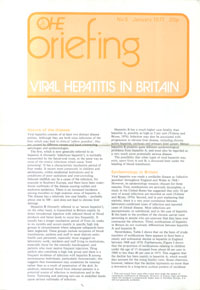Sign up to our newsletter Subscribe
Analysing Global Immunisation Expenditure

Viral hepatitis consists of at least two distinct disease entities. Although they are both virus infections of the liver which may lead to clinical ‘yellow jaundice’, they are caused by different viruses and have contrasting aetiologies and epidemiologies.
The first, which is now…
Viral hepatitis consists of at least two distinct disease entities. Although they are both virus infections of the liver which may lead to clinical ‘yellow jaundice’, they are caused by different viruses and have contrasting aetiologies and epidemiologies.
The first, which is now generally referred to as hepatitis A (formerly ‘infectious hepatitis’), is normally transmitted by the faecal-oral route, in the same way as most of the enteric infections which cause ‘food poisoning’. It has a characteristic incubation period of four weeks. It occurs most commonly in children and adolescents, within residential institutions and in conditions of poor sanitation and over-crowding. Infected shellfish can be a cause of the infection, for example in Southern Europe, and there have been waterborne outbreaks of the disease causing sudden and explosive epidemics. There is an increased incidence among travellers to high endemic areas of hepatitis A. The disease has a relatively low case fatality – probably about one in 500 – and does not lead to chronic liver damage.
Hepatitis B (formerly referred to as ‘serum hepatitis’), on the other hand, is transmitted in Britain mainly by direct intradermal injection with infected blood or blood products and hence tends to occur less frequently. It usually has a longer incubation period of from six weeks to six months and occurs mainly in specific high risk groups in circumstances where adequate safeguards have been neglected. These groups include recipients of blood transfusions; patients and staff in renal dialysis units; health care personnel, especially those engaged on laboratory work; residents and staff living in institutions, especially those for the mentally handicapped ; and patients who must receive frequent injections. Drug addicts also constitute a high risk group and there is a frequent incidence of infection with hepatitis B among promiscuous individuals, particularly homosexuals; this suggests that transmission may sometimes be venereal rather than as a result of penetration of the skin. In addition, menstrual blood from infected patients is a potential source of infection in institutions and in the home. Tattooing and piercing ears can in unskilled hands cause serious outbreaks of infection.
Hepatitis B has a much higher case fatality than hepatitis A, possibly as high as 5 per cent (Tolsma and Bryan, 1976). Infection may also be associated with progression to chronic liver disease, including chronic active hepatitis, cirrhosis and primary liver cancer. Hence hepatitis B presents quite different epidemiological problems from hepatitis A, and must also be regarded as a very much more potentially serious disease.
The possibility that other types of viral hepatitis may exist, apart from A and B, is discussed later under the heading of blood transfusion.
Viral Hepatitis in Britain


